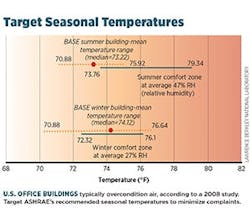Why Thermal Complaints Persist
No matter the season, occupants are likely to complain about the temperature. You may have noticed that sick days increase at a certain point in the season. What you may not know is that your target temperature could be the culprit, even if you keep occupants from adjusting thermostats.
U.S. office buildings tend to overcondition year-round by targeting a similar temperature no matter the season, according to Indoor Thermal Factors and Symptoms in Office Workers, a 2008 study by the Lawrence Berkeley National Laboratory. This not only drives up complaints, but also contributes to absenteeism when occupants develop building-related symptoms as a result.
Adjust Your Conditioning
Occupants may be happier if you stick to the cooler end of the thermal comfort range defined in ASHRAE 55, according to the research team. Maintaining the wintertime building temperature below 73 degrees F. (the midpoint for ASHRAE’s comfort range in winter) can both decrease symptoms and reduce energy use.
Likewise, in summer, buildings are often so overcooled that temperatures miss thermal comfort guidelines entirely. In both cases, target the recommended seasonal temperatures (about 74-79 degrees F. for summer and 72-76 in winter) for optimal results.
These results “suggest benefits from less thermal conditioning of the outdoor air than was observed,” the team notes. “It is often assumed that energy conservation measures in buildings will decrease thermal comfort ... Energy-saving changes in current thermal management practices in U.S. buildings (less heating in winter, less cooling in summer) may have both health and thermal comfort benefits.”
As you adjust setpoints, know that temperature management isn’t the entire story. In addition to factors like relative humidity and occupant clothing level, there may also be a mechanical issue.
“We design systems for the peak day,” explains Dr. John Stoops, senior principal consultant for DNV KEMA Sustainable Use Consulting and a member of the ASHRAE Standard 55 committee. “Most days are far from the peak day, so the system is running just a few minutes every hour. If you’re faced with a dehumidification problem as we commonly see in the Southeast, the only way to dehumidify is to run the system longer, which sub-cools the space, and that adds to the discomfort people are feeling.”
Next Steps
If the problem persists, it’s time to do some diagnostic work. You need a thorough understanding of the weak points and potential failures of your system, which then allows you to work your way down a logical hierarchy of where the problem could be.
“If the outside air dampers on your economizer are rusty or stuck, or if actuators break or become disconnected, the system is forcing cold air into the space when it’s not needed,” Stoops explains. “If capacity is in question, check the function of the chiller and heat source. Is it producing the cooling or heating you’d expect? Has refrigerant leaked out?”
If the equipment is in good shape, an exterior project such as window upgrades will provide a more uniform temperature. However, Stoops notes, it’s important to maintain the right perspective.
“Expect some complaints,” Stoops explains. “Standard 55 recognizes that even the best spaces can never expect to achieve 100% occupant thermal satisfaction.”
